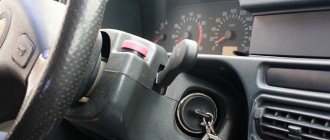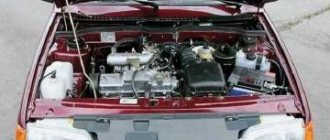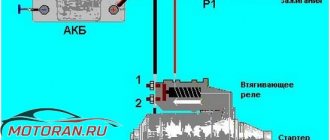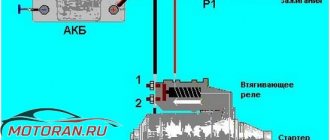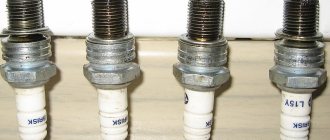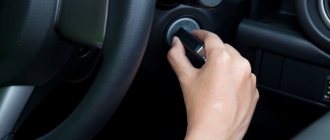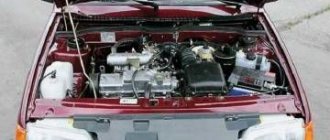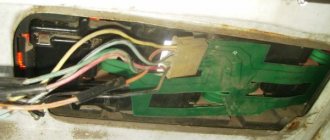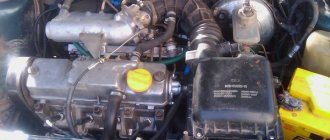Fuel pressure control
The regulator consists of a membrane and a spring. During a malfunction, it may hang open and because of this, the fuel pressure in the system will not be enough for the engine to operate correctly and to start it, so the engine stalls when cold.
To check the functionality of the valve, it is not enough to simply remove the hose from the pump and see how strong the gasoline pressure is. Diagnostics must be carried out with a pressure gauge. There is a special connector for it on the fuel rail. We connect the device and try to start the engine. If the pressure in the system is below 3.6-4.0 atm , this is an indicator of a problem in the fuel supply system.
It is better to replace the pressure regulator in a special service, but if you want to do this process yourself, then follow the instructions:
- Disconnect the battery terminal;
- Remove the hose from the vacuum brake booster;
- Drain gasoline from the system;
- After this, start disconnecting the fuel rail from the pressure regulator.
- Replace and install everything in place.
If all work is performed correctly, the fault in this part of the system will be eliminated.
HBO for cars
A hot engine can also cause a breakdown in the case of an installed gas system. Since driving on gas has recently become profitable, many drivers switched to this type of fuel, however, they did not take into account some of the nuances of the new system. In hot weather, gas expands more, which leads to increased pressure inside the system and often causes damage. This is why it is bad to drive on gas in the heat.
The result is an extremely dangerous situation. To avoid this, try not to fill the tank to full gas in the summer, this will reduce the pressure in the system and the risk of breakdown. If a similar problem occurs, it is recommended to let the car cool down and then visit a service station. You should not repair the gas system yourself; the equipment should be adjusted by a specialist.
Weak battery or oxidized terminals
The starter does not turn - this is another common problem. Its cause may be deposits or corrosion on the battery terminals or a dead battery.
Remember that the generator will not be able to charge the battery completely and from time to time it is advisable to charge it from the mains. This will help it not lose its capacity and increase its service life.
If you notice that the terminals have strange deposits on them, you should clean them and treat them with a special lubricant that will prevent a similar problem from occurring again.
INDEPENDENT DIAGNOSTICS IN THE GARAGE
If you have problems with the operation of the injection system, you should first diagnose the ECU. In this regard, the owners of the VAZ 2114 are more fortunate with the German VDO instrumentation - it has a self-diagnosis mode. On cars with a dashboard from Schetmash there is no such functionality.
VDO dashboard for VAZ 2114
Working with the self-diagnosis mode on the VDO panel is carried out according to the following algorithm:
- With the ignition off, hold the odometer button for several seconds;
- turn the ignition to position “1”, release the button;
- if the arrows start running on the display, everything is fine, press once (information message about the firmware version) and release, with a second press an error code will appear;
- You can reset the error by holding the button until “0” appears.
Injection problems that cause the car to stall can be indicated by the numbers 1 (ECU error), 14,15 (coolant sensor errors), 22, 23 (DPS errors), 33, 34 (MAF errors), 42 (ignition malfunction) , 44, 45 (lean or rich mixture). The disadvantage of self-diagnosis on the VAZ 2114 is that if there are several errors, the system sums up the codes. Thus, the number “22” may mean a TPS error or low on-board voltage and a coolant sensor error (8 + 14).
For more accurate diagnostics of the injector, you need to immediately contact a service center or purchase a diagnostic scanner (it costs about 1000 rubles).
If you have another car, you can find the problematic sensor by replacing the sensitive elements one by one with known good ones.
Electricity problems
If fuel is supplied to the engine, but starting does not occur, you should look for an electrical failure.
First of all, you need to inspect the ignition. May not work:
- candles;
- coil;
- spark distributor.
It never happens that all nodes fail at the same time, so it is necessary to talk about each of them in more detail. In particular, if there are no problems with the ignition distributor, then most likely there is a breakdown of either the slider or the cover. The engine may not start due to a Hall sensor failure.
But the most common problem is improper contact at the supply terminal of the ignition distributor. However, the problem often arises due to the inability of the coil to produce the required voltage. As you know, the injector works together with the ignition module. There are two of them in the engine design. The first is in charge of the functioning of the 1st and 4th cylinders, the other, respectively, of the second and third.
As a result, even when the spark plugs are dry, a spark does not appear on them.
It may well be that the problem arose in the ECU, since it is in charge of generating commands for each installed system, and ignition is no exception. The only way to check the functionality of the on-board computer is to replace it with a known working unit. The suitability of the ignition module is checked in the same way.
If, however, a breakdown occurs in the coil, then a fairly simple test will allow you to verify its malfunction. The spark plugs are unscrewed from their sockets without removing the wires and placed against the ground of the car. Next, turn the starter. If a spark does not appear, it means that the coil has become unusable and cannot produce enough voltage to ignite the fuel.
It is also worth pointing out that the reason why the car does not want to start sometimes lies in the spark plugs themselves. It is this element that is responsible for the ignition of the fuel-air mixture. During operation, their metal parts burn out, which leads to an increase in the gap. The latter circumstance often either complicates the launch or makes it impossible. You should check the gap more often, and then no problems with the spark plugs will arise.
Bad ground on the engine
What to do if the VAZ 2114 starts and immediately stalls? It is worth checking the ground on the body and engine. The terminals there may oxidize or rust. Check their condition, if everything is normal, it is worth checking the wires for integrity.
An undercharged battery may be due to poor mass conductivity through the engine. To avoid such problems, after cleaning and checking, it is worth treating all connections with a special lubricant.
What could happen to electrical equipment?
If there is something to burn in the working cylinders, then you need to look for what will make the mixture burn
This means that you need to pay attention to the car's ignition system. This could be the ignition distributor, high-voltage coil and wires, spark plugs
It doesn’t happen that all devices fail at the same time, so we should talk about them separately.
We will assume that the distributor is installed correctly; in this case, a failure may occur through a breakdown of the cover or slider, or a failure of the Hall sensor. However, most often the cause is poor contact in the power connector of the ignition distributor. An ignition module or coils that do not produce high voltage to produce a spark at the spark plugs can create problems.
Injectors work in conjunction with ignition modules, of which there are usually two per engine. One ensures the operation of cylinders 1 and 4, and the second - cylinders 2 and 3. In these systems, the electronic control unit, which generates control pulses for all systems, including the ignition, may be problematic. This block can only be checked by replacing it. The same can be done with ignition modules.
Sometimes the malfunction may come from the high-voltage coil; it does not produce voltage that can form a spark to ignite the air-fuel mixture. You can check its operation if you unscrew the spark plug from the cylinder and, together with the high-voltage wire, ensure its contact with the engine ground. At this time, you need to crank the starter and watch the spark plug. The absence of a spark confirms that the ignition coil is faulty.
It is impossible not to dwell on such elements of ignition systems as spark plugs. They are the ones who ignite the combustible mixture in the working cylinders of the engine. During their operation, the metal parts of their electrodes burn out, after which the gap increases, starting the motor becomes more difficult, or even becomes impossible. Check the condition of the spark plugs regularly, especially their gap, then problems can be avoided.
Clogged breather
If the car starts and stalls when cold, then perhaps the reason is a clogged breather. The problem occurs due to the high mileage of the car, the use of low-quality oils, or wear of the piston group.
An engine malfunction can be diagnosed using several points:
- Increased oil consumption. It is thrown out of the engine into the intake and exhaust;
- The spark plug electrodes become oily;
- Drives oil out of the engine under the seals and gaskets.
If obvious signs of malfunction are detected, minor repairs will be required. It is necessary to remove the engine valve cover and thoroughly clean it of oil and dirt. It is also worth blowing through all the channels to clean them. Then we put everything back together.
Useful tips
Additionally, experts advise turning your attention, when all other options have already been excluded, to the timing belt - when replacing it, the technicians could have set the phases incorrectly. In addition, a banal belt break or excessive rotation is likely.
In addition, a banal belt break or excessive rotation is likely.
Very exceptional situations include a skewed cylinder head (for example, due to overheating), impaired compression in the cylinders and misaligned rings.
One should not discount such a banal reason as low-quality fuel: in places far from cities, where there is nothing to choose from, cunning entrepreneurs can pour in a completely indecent mixture.
The engine will not start immediately from such gasoline, which will serve as an additional diagnostic sign, and there can only be one solution - drain the low-quality fuel and fill it with normal gasoline. In such situations, however, there is nowhere to take it from, so you will have to rely on a tow truck or compassionate motorists who will stop to help.
Main reasons and methods for solving them
Healthy! Maybe you are lucky and resetting the injector errors will help. To do this, you first need to remove the negative terminal from the battery. If after 5-10 minutes the car starts as well, then this is not the problem.
Difficulty starting the engine is influenced by a number of simple reasons, which you can eliminate yourself in the garage, having a standard set of tools with you.
Starter mechanisms (brushes, bendix)
In the process of rebuilding the starter. The arrow indicates worn brushes.
- On used cars, the brushes on the starter wear out. In this case, you need to remove the cover and replace them with new ones;
- A starter that has been in use for a long time can be sorted out, cleaned all the mechanisms, washed with WD-40 and filled with new lithol, since the old one is most likely coked and formed into balls;
Fuel problems
In the process of replacing the fuel pump grid. On the right is the old one, and on the left is the new coarse mesh
Small particles of debris getting into the gas tank. This problem is treated by cleaning the fuel system and replacing the filter.
Incorrect sensor readings
Failure or incorrect signal supply from the sensors to the ECU (their diagnostics are required, and if a malfunction is detected, replacement with new ones):
- Speed sensor.
- Crankshaft position sensor.
- Idle speed sensor.
- Phase sensor.
Wires, filter and spark plugs
Clogged air filter
- High-voltage wires are broken, poor contact on the tips (oxidation). During a visual inspection, it is rarely determined whether the best option is to replace it with new or known good ones. Before replacing, you can clean (blow out) the contacts on the old wires.
- The spark plugs are flooded, mechanically damaged, or the gap is set incorrectly. If necessary, the following is done: new ones are screwed in, the required gap is set, or the old ones are returned to their place.
- The air filter is clogged, causing the air supply to the engine combustion chamber to deteriorate. It is recommended to replace with a new one.
Gasoline pump
The fuel pump is located under the rear seat
The fuel pump does not provide the required pressure, which is why the injectors do not spray fuel, but simply splash it. In order to discard this option, you need to measure the fuel pressure with a pressure gauge (the nominal one should correspond to the norm of 3.2 bar).
If the result is different, the situation requires replacing the fuel pump.
Engine failure
Reduced compression in the cylinders is one of the most terrible situations for a car owner. In this case, flammable gases enter the crankcase, and new vapors do not ignite.
Preparing to measure engine compression
In this situation, replacement of the piston rings is required, and perhaps a major overhaul of the engine.
The starter works, the engine turns, but the car does not start
So, the starter spins, the engine spins, the pistons move, but the engine still won’t start. Here the problem is most likely in the fuel-air mixture, perhaps the marks have come off, etc.
Before sinning on the fuel-air mixture, the first thing you need to pay attention to is the crankshaft sensors:
DPKV - if it malfunctions, it is very difficult to start the engine, and the running engine runs unevenly, intermittently, and the power drops noticeably.
Next you should pay attention to the labels:
- Mark on the timing camshaft gear (photo).
- Markings on the flywheel under the thermostat (photo).
If the marks do not match, most likely the belt has simply slipped by one tooth, the camshaft gear itself may be worn out, it needs to be adjusted and installed correctly!
Next we will talk about the air-fuel mixture.
I warn you in advance that the easiest way is to do computer diagnostics of the engine or look at the errors on the on-board computer.
The air-fuel mixture is the combination of air, gasoline and the spark needed to ignite it.
Air supply
As a rule, a malfunction in the air supply should not affect the problem of starting the engine. For better or worse, the engine should still run. However, we will not go through the air system sideways.
We recommend: What to do if you start burning oil, and will additives help to restore the engine?
The following sensors are responsible for air metering and supply:
- Mass air flow sensor is the most expensive sensor; if it fails, then the car simply begins to consume liters of gasoline, then this sensor can simply die “to zero”, but it indirectly affects the starting of the car. That is, no matter how it fails, the car should start.
- IAC - should not affect the problem of starting the engine. If it malfunctions, problems arise at idle.
Spark
Here may be the real reasons for our problem:
- First of all, we look at the candles. We turn the candles out (How to remove the candles?) and look at their condition:
- Next, check for the presence of a spark. To check the spark, see the following article: How to check the spark?
A normal spark plug should have a slightly brick color; if the spark plug is wet, the spark plugs are flooded; you need to clean and bleed the cylinders by cranking the engine at idle with the starter with the spark plugs turned out. If one cylinder is flooded - the problem is local (High-voltage wires, faulty spark plug, injector), all cylinders are flooded - a general problem (ignition coil, brains, oxygen sensor, fuel pressure in the rail)
- If there is no spark on one cylinder, there is a faulty spark plug or high-voltage wire.
- If there is no spark on two adjacent cylinders (1-4 or 2-3), then the problem is in the ignition coil or in the ECU.
- If there is no spark anywhere, then the problem may lie in the ignition coil or in the ECU, in mismatched timing marks, or in a non-working DPKV.
- If there are no problems with the presence of a spark, then the problem lies in the fuel supply.
Fuel supply
Two points are very important in fuel supply:
- normal fuel pressure;
- working injectors.
If, when you turn the key into the ignition, you do not hear the fuel pump pumping, then therein lies the problem. If the pump pumps, then first of all we measure the pressure in the fuel rail: How to measure the pressure? and draw appropriate conclusions.
High fuel rail pressure coupled with a malfunctioning fuel pressure regulator can flood your engine in an instant.
6. Crankshaft sensor malfunction
If you are looking for the answer to the question “why does the VAZ 2114 stall when cold,” then pay attention to the crankshaft sensor. It is responsible for controlling ignition and fuel, and if its operation is disrupted, then processes in the engine will occur at the wrong time. You can easily diagnose the problem thanks to the check - if there is a malfunction, it will blink or light up. To replace the sensor, it is better to contact a service center. You can do this yourself, but it is advisable to drive onto an overpass or pit for convenience.
Less commonly, the mass air flow sensor fails, which will affect engine performance.
Why does the VAZ 2110 injector engine take a long time to start?
There are many reasons why the fuel-injected VAZ-2110 with 8 valves does not start well after being parked overnight.
A particularly common situation is when everything was fine in the evening, and in the morning an unpleasant surprise is discovered in the form of a non-working car. Next, we will consider what reasons can lead to difficulties in starting the injection VAZ-2110 and what to do to fix the problem. To determine why a car has trouble starting, you need to know how it works. A spark is responsible for starting the engine, which, in turn, is completely dependent on the ignition system and the fuel-air mixture, supplied in precisely metered proportions.
If one component of this chain is broken, starting is problematic or completely impossible.
Engine starting
There are several fairly simple rules, following which you can relatively easily start your car engine in cold weather.
Before starting, you should, as they say, wake up the battery. To do this, just turn on the headlights on high beam for just a few minutes. Then, turning on the ignition, you need to wait 10-15 seconds. During this time, the fuel pump will have time to pump fuel into the injection engine. After this, they press the clutch - the starter turns a certain number of parts, and this action will reduce their number and reduce energy consumption.
The timing marks are off
Another problem that the engine on a VAZ 2114 is difficult to start can be a skipped timing belt. This happens when there is poor tension or excessive wear. A discrepancy of more than two teeth will be significantly noticeable in the operation of the motor.
To check the mechanism, it is enough to remove the timing belt protective cover. Afterwards we mark it and check it.
If a discrepancy is found, repairs will have to be made. It is better to contact a good service station with this problem.
When faced with the problem of poor cold starting with a VAZ 2114, you should not hope that normal warming up of the engine will help fix it. Cars of this brand are quite simple, and if any problem arises, it should be looked for in the mechanics, since there are not many electronic systems here.
Fuel system
If it is below -20 degrees outside the window, it is possible that condensation has formed in the tank. The presence of water in gasoline is a bad sign. Moreover, it is not necessary that it be “diluted” at the gas stations themselves. Due to the temperature difference, condensation forms on the walls of the tank. At low temperatures it freezes. As a result, the VAZ-2115 (injector, 8 valves) does not start. Frozen water can be both in the fuel lines and in the filter itself. There is no point in trying to turn the starter with the hope that the car is about to start. You'll just drain the battery. The only solution to the problem is to warm up the car. It's better if it's in a garage with this problem. By installing an oil or induction heater there, you will quickly warm up the air temperature in the room. And the car will start successfully.
Diesel engines
If the diesel engine does not start when hot, then the fault should be looked for in the fuel injection pump. Most often, the breakdown is simple and trivial - the oil seals and bushings have failed. The problem can be solved by servicing the pump. But the reason for the non-start may also be in the plunger pair - to solve this problem, a major overhaul of the pump is required.
The same problems are observed in the case of a faulty OPTS. To remove the plunger, the fuel injection pump from the rear is cooled, and then attempts are made to start the car. If the car starts, then the plunger pair is to blame.
If the car does not start when hot, the reason may be worn out oil seals, as well as the bushings of the injection pump drive shaft. There is a place under the seal from which the pump sucks air. This does not allow creating the required pressure in the plunger chamber. To treat and improve the situation, replace the oil seals and bushings.
